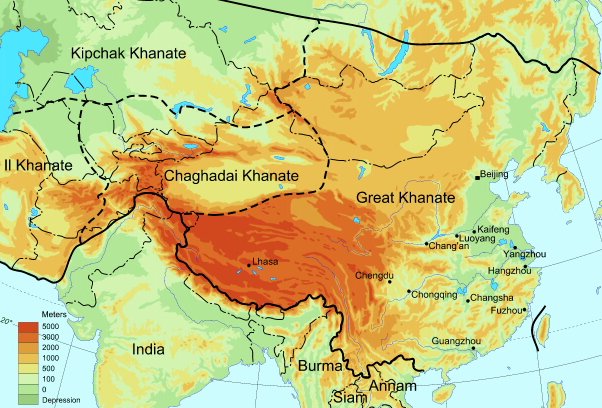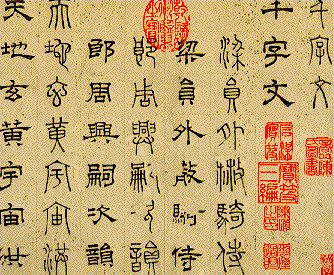
Yuan Dynasty Territory |
Yuan Dynasty (1271 - 1368)

Yuan Dynasty Territory |
As
the Sung Dynasty’s military power was declining, the Sung soldiers were even
defeated by the minority races from the north of its territory. In 1127, the
Sung Dynasty had to move to the south. It was then called the South Sung. Later
the South Sung was conquered by the Mongolian. The Mongolian ruled over the Han
people and established the Yuan Dynasty.
During
the Yuan Dynasty’s short span of life, there were only two renowned calligraphers:
Xien-Yu Su (who died at only 40 years old) and Zhao Meng-Fu. Zhao Meng-Fu was ambitious to
revitalize calligraphy styles of the Jin and Tang Dynasties while Xien-Yu Su was
focusing on creating a new personal style.
· Xien-Yu Su 鮮 于 樞 (1257-1302): He studied Zhang Tien-Si’s work first, then the calligraphy works of the Jin & Tang Dynasties to establish his style. He inherited the spirit of the Two Wangs (Wang Hsi-Chih and his son, Wang Hsian-Chih.)
· Zhao Meng-Fu 趙 孟 頫 (1254-1322): He was famous for various styles. He was a descendant of the royal family of the Sung Dynasty. He had great influence on later calligraphers in the Ming Dynasty. He and Xien-Yu Su deeply respected each other's achievement.
Buddhist Heart Sutra
|
Zhang Yu ( 張雨 ) |
|
Download links of Zhang Yu's calligraphy: http://www.flickr.com/photos/52351380@N02/sets/72157624450985963/ http://www.9610.com/yuan/zhangyu/ (Several links on left)
Zhang
Yu (1277?-1348?) was from Hangzhou in Zhejiang. He had a high reputation
as a sage and was also an excellent poet whose calligraphy was said to
be free from all vulgarity. He became a Taoist around the age of twenty. There
were several accounts
of his birth and death years and age. He
learned calligraphy from Zhao
Mengfu
and met other literary friends, painters, and calligraphers. His poems,
calligraphy, and painting were highly regarded by Ni
Zan (
倪瓚
).
His calligraphy was characterized by utilizing different kinds of
strokes and was not confined by his teacher Zhao Mengfu and the
traditional Centered Tip approach.
張雨,字伯雨,一字天雨,號貞居子。浙江錢塘人。元代著名詩人、方外之士。 關于其生卒年歲問題, 歷來眾說紛紜。其生年有兩種說法: 至元十四年(1277年)、至元二十年(1283年)。關于其卒年, 有五種說法: 至正六年(1346年)、至正八年(1348年)、至正九年(1349年)、至正十年(1350年)、至正十二年(1352年)。經考證, 張雨生卒年可推定為: 生于至元二十年, 卒于至正十年(1283~1350年), 享年68歲。另一說為生於元世祖十四年(1277),卒於元順帝至正八年 (1348年),年72歲。張雨號"句曲外史"的得名緣由概有三說, 經考辨其是以陶弘景自況也。 張雨在二十歲左右棄家為道士,往來華陽雲石間,自稱句曲外史,能詩詞、工書翰,與元代重要文人虞集,楊維楨往來,著有句曲外史集。
《登南峰詩》
張雨的書法初學趙孟頫,後上溯至張旭、懷素,將楷書與行草結合,構成一種特別具有個性的書風。宋代講求文人優美的字體,在元初仍由趙孟頫繼承,但在元中期以後,書法的繪畫性被大量開發,書法家的用筆有時甚至不遵守傳統的中鋒,例如張雨的一首七言律詩,字體的大小、正側、粗細、輕重,都不一致,變化非常大,第一眼的印象有些不統一,甚至很怪異。但是慢慢欣賞,會發現作者已把書法的各種可能一一發展到極端,使毛筆如樂器,在流動飛揚,沉著頓挫中交錯出更多生命的感受。在這樣的書法中書法的繪畫性被高度開發了創作者更直接地以完全個人的性情使文字舞動起來,構成視覺美的另一種風貌。這是張雨登南峰絕頂的一首詩,經由書法線條,似乎我們也經歷了作者登山的驚險、喜悅、錯愕,或奮勵的激動。
|
· Yu He 俞 和 (1307-1382): He had an excellent emulation work of Wang Hsi-Chih’s Lang Ting Prologue. He also specialized in small-scale calligraphy that deeply influenced Zhao Meng-Fu.
